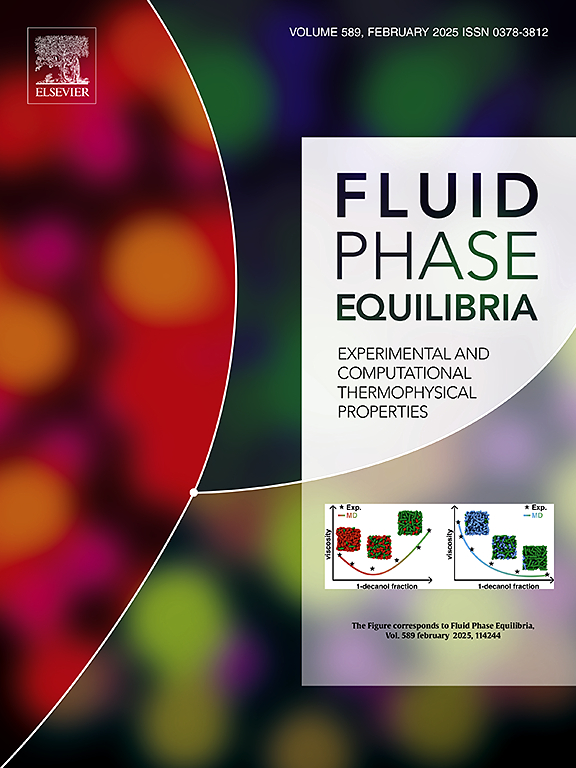CO2 solubility in aqueous 1-methylpiperazine and its blend with 2-amino-2-methyl-1-propanol: New experimental data and leveraging Random Forest model for accurate prediction
IF 2.8
3区 工程技术
Q3 CHEMISTRY, PHYSICAL
引用次数: 0
Abstract
A new study of amines with enhanced properties is crucial for its use as an appropriate solvent for CO2 absorption process. This is essential to overcome current financial and environmental obstacles to implementing large-scale CO2 capture. In this work, the identified amines to formulate a good aqueous solvent mix are 1-methylpiperazine (1-MPZ) and 2-amino-2-methyl-1-propanol (AMP). 1-MPZ has a higher thermal resistance and lower CO2 regeneration cost, which makes it a potential candidate for the process. This paper presents the results of experiments on the equilibrium solubility of CO2 in aqueous 1-MPZ solutions and its blends with AMP along with new vapor pressure data for aqueous 1-MPZ and its blend with AMP. The study examined CO2 solubility at 0.10, 0.20, 0.30, and 0.40 wt fraction (w) of 1-MPZ and temperatures of 303.15, 313.15, 323.15, and 393.15 K. The CO2 solubility experiments for the new blended mixture of AMP + 1-MPZ were also performed in this study. Four different sets were prepared by varying the individual concentrations of 1-MPZ and AMP; keeping the total amine concentration 0.40 w for the same temperature range. The experimental results indicate that aqueous 1-MPZ exhibits good cyclic capacity for CO2 intake which further enhances when combined with AMP. Results indicate that aqueous 1-MPZ exhibits high CO2 solubility of 0.78 to 1.01 moles of CO2/moles of amine at normal absorber conditions of temperature and composition. Again, the addition of 1-MPZ to AMP has increased the cyclic capacity. The blended aqueous amine (AMP+ 1-MPZ) shows a cyclic capacity of 118 g CO2/kg-solution whereas aqueous 1-MPZ of the same amine strength shows only 81 g CO2/kg-solution. Hence, an increase of about 45% cyclic capacity is achieved with the blended solvent. The combination of 1-MPZ+AMP allows for improved performance in terms of both solubility and regeneration efficiency. The study also incorporated Random Forest (RF) machine learning model to predict CO2 solubility based on parameters like temperature, concentration, and CO2 partial pressure. The RF model demonstrated excellent prediction accuracy with R2 values of 0.98 and 0.99 for both solutions and least RMSE values of 0.03 and 0.02 for 1-MPZ and (1-MPZ +AMP) blend respectively.
求助全文
约1分钟内获得全文
求助全文
来源期刊

Fluid Phase Equilibria
工程技术-工程:化工
CiteScore
5.30
自引率
15.40%
发文量
223
审稿时长
53 days
期刊介绍:
Fluid Phase Equilibria publishes high-quality papers dealing with experimental, theoretical, and applied research related to equilibrium and transport properties of fluids, solids, and interfaces. Subjects of interest include physical/phase and chemical equilibria; equilibrium and nonequilibrium thermophysical properties; fundamental thermodynamic relations; and stability. The systems central to the journal include pure substances and mixtures of organic and inorganic materials, including polymers, biochemicals, and surfactants with sufficient characterization of composition and purity for the results to be reproduced. Alloys are of interest only when thermodynamic studies are included, purely material studies will not be considered. In all cases, authors are expected to provide physical or chemical interpretations of the results.
Experimental research can include measurements under all conditions of temperature, pressure, and composition, including critical and supercritical. Measurements are to be associated with systems and conditions of fundamental or applied interest, and may not be only a collection of routine data, such as physical property or solubility measurements at limited pressures and temperatures close to ambient, or surfactant studies focussed strictly on micellisation or micelle structure. Papers reporting common data must be accompanied by new physical insights and/or contemporary or new theory or techniques.
 求助内容:
求助内容: 应助结果提醒方式:
应助结果提醒方式:


